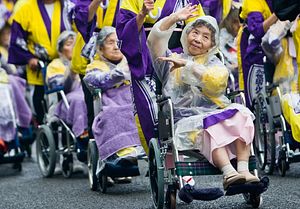Asia’s aging crisis has hit Japan hard while also threatening economic growth in South Korea and even China. Now, the supposedly anti-work Australians have been told the retirement age should rise to 70 years to avoid a budget blowout.
In a new report, the Australian government’s Productivity Commission has warned that the “Lucky Country” faces a major slowdown in per capita income growth due to an aging population, with welfare spending to surge while the labor force shrinks.
In a statement released Friday, the commission said “unless ‘luck or appropriate policies intervene,’ net national income per capita, the best single measure of national prosperity, may grow by only 1.1 percent per annum over the next five decades. In the last 20 ‘boom’ years, the yearly growth rate was 2.7 per cent.”
The commission warned that population aging would threaten the federal government’s plans to return the budget to surplus, costing an extra 6 percent of gross domestic product (GDP) by 2060, or the equivalent of A$90 billion, due to growing healthcare and pension costs.
Labor force participation is forecast to decline to 60 from 65 percent by 2060, with forecast average labor productivity growth of 1.5 percent a year, well below economists’ expectations.
Despite the effects of immigration, the number of Australians aged 70 years and over is expected to increase by 4 million by 2060, accounting for 14 percent of an estimated 40 million population.
The number of Australian centenarians is expected to reach 25 for every hundred babies. This will still be well below countries such as Japan, which already has more than 54,000 centenarians in total, including an 115-year-old Osaka resident.
“Without broader policy reforms, it appears that it will be difficult to return to the higher growth rates experienced in the 1990s…The bottom line is that the combined cocktail of falling labor supply per capita, a declining terms of trade and poorer productivity growth rates mean that Australians can expect that the growth in disposable income per capita will fall to less than half that of the boom years,” the commission said.
Closing The Gap
The commission’s forecasts likely make unpleasant reading for the new Australian government, which has pledged a budget surplus of 1 percent of GDP within a decade.
The commission warned that closing the long-term fiscal gap would require a 21 percent hike in taxes to 34 percent of GDP, an equivalent cut in spending or a combination of the two.
Fortunately for populist politicians, the commission suggested some alternatives to fiscal pain, including increasing the eligibility age for the age pension from the current target of 67 by 2023 to 70, yielding estimated savings of A$150 billion.
Other reforms proposed included encouraging households to use equity in their homes to pay for aged care costs, which could reduce government spending by an estimated 30 percent. Improving the productivity of healthcare delivery could also reduce spending by 0.5 percentage points of GDP by 2060, the commission said.
Aging Asia
One of the fastest aging nations in the developed world, Japan has already moved to increase the mandatory retirement age to 61 this year and 65 years by 2025. The number of elderly people aged 65 and over has already reached 30 million, accounting for 24 percent of the total population and outnumbering children.
With immigration considered politically unpalatable, Japan’s shrinking and aging population threatens the nation’s position as a major economic and political power, as previously noted by The Diplomat.
Neighboring South Korea has also moved to hike the mandatory retirement age to 60 from 2016, amid projections that it will become a “super-aged society” by 2026 and the second-oldest in the world by 2050.
According to a recent report by the Korea Statistical Office, the number of South Koreans aged 65 and over has surpassed 6 million, accounting for nearly 12 percent of the population, with the ratio of senior citizens to those of working age forecast to shift from the current 1 to 6 ratio to 1 to 1.5 by 2060.
Although recently slightly relaxed, China’s one-child policy is forecast to cut 3.25 percentage points off its annual growth rate through to 2030, ending its boom period of double-digit growth.
Citigroup economists have forecast that China’s diminishing working-age population will restrict GDP growth to a maximum 6.9 percent a year over the next two decades, “and to the extent that urbanization, industrialization and convergence dynamics play through (as is likely) actual growth will be substantially lower.”
The current mandatory retirement age in China is as low as 50 for women and 60 for men, despite reported efforts by some sections of the central government to hike the retirement age in the world’s most populous nation to 65.
For the Asia-Pacific’s hard-working citizens, the prospect of an early retirement appears further away than ever. But then who wants to just quit and play golf?

































